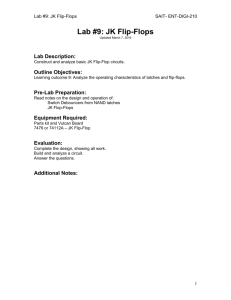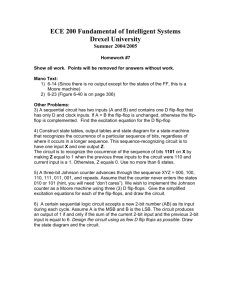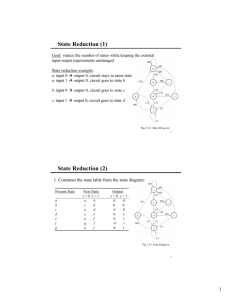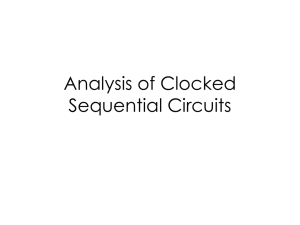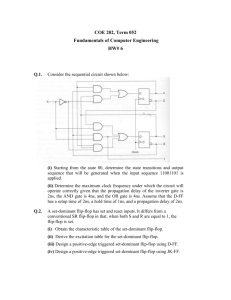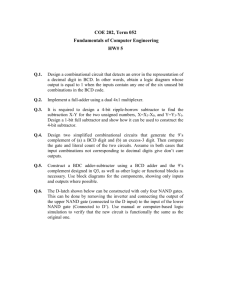5.7 STATE REDUCTION AND ASSIGNMENT
advertisement
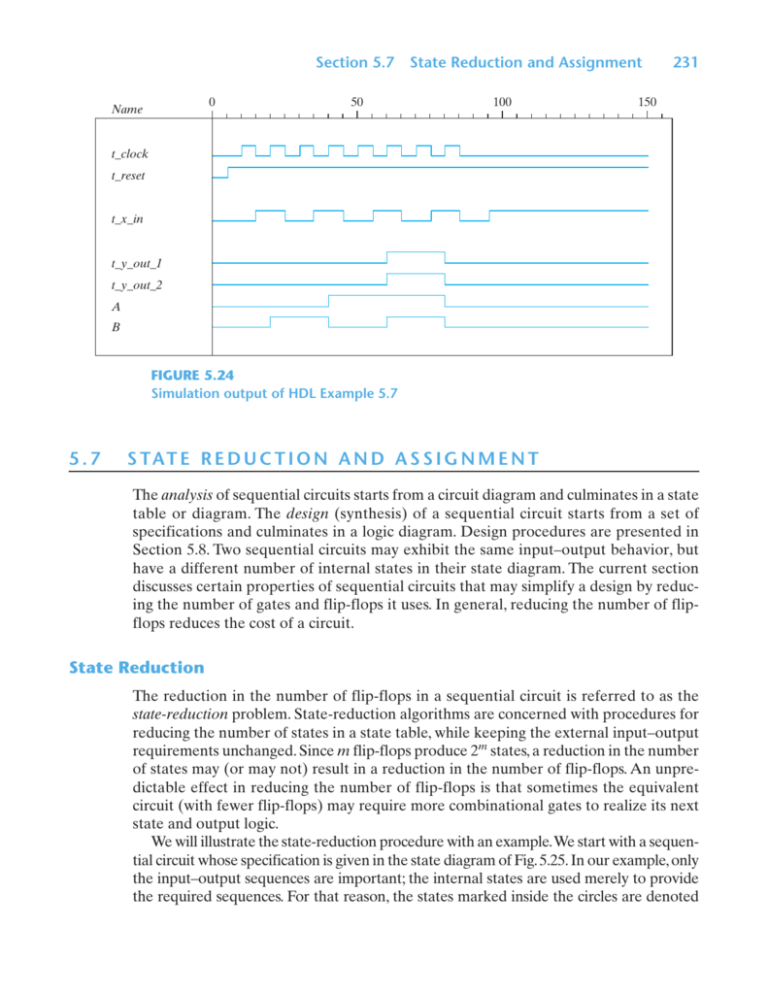
Section 5.7 0 Name 50 State Reduction and Assignment 100 231 150 t_clock t_reset t_x_in t_y_out_1 t_y_out_2 A B FIGURE 5.24 Simulation output of HDL Example 5.7 5.7 S TAT E R E D U C T I O N A N D A S S I G N M E N T The analysis of sequential circuits starts from a circuit diagram and culminates in a state table or diagram. The design (synthesis) of a sequential circuit starts from a set of specifications and culminates in a logic diagram. Design procedures are presented in Section 5.8. Two sequential circuits may exhibit the same input–output behavior, but have a different number of internal states in their state diagram. The current section discusses certain properties of sequential circuits that may simplify a design by reducing the number of gates and flip-flops it uses. In general, reducing the number of flipflops reduces the cost of a circuit. State Reduction The reduction in the number of flip-flops in a sequential circuit is referred to as the state-reduction problem. State-reduction algorithms are concerned with procedures for reducing the number of states in a state table, while keeping the external input–output requirements unchanged. Since m flip-flops produce 2m states, a reduction in the number of states may (or may not) result in a reduction in the number of flip-flops. An unpredictable effect in reducing the number of flip-flops is that sometimes the equivalent circuit (with fewer flip-flops) may require more combinational gates to realize its next state and output logic. We will illustrate the state-reduction procedure with an example. We start with a sequential circuit whose specification is given in the state diagram of Fig. 5.25. In our example, only the input–output sequences are important; the internal states are used merely to provide the required sequences. For that reason, the states marked inside the circles are denoted 232 Chapter 5 Synchronous Sequential Logic 0/0 0/0 a 1/0 0/0 0/0 b 1/0 g d c 1/0 0/0 e 1/1 1/1 0/0 0/0 1/1 f 1/1 FIGURE 5.25 State diagram by letter symbols instead of their binary values. This is in contrast to a binary counter, wherein the binary value sequence of the states themselves is taken as the outputs. There are an infinite number of input sequences that may be applied to the circuit; each results in a unique output sequence. As an example, consider the input sequence 01010110100 starting from the initial state a. Each input of 0 or 1 produces an output of 0 or 1 and causes the circuit to go to the next state. From the state diagram, we obtain the output and state sequence for the given input sequence as follows: With the circuit in initial state a, an input of 0 produces an output of 0 and the circuit remains in state a. With present state a and an input of 1, the output is 0 and the next state is b. With present state b and an input of 0, the output is 0 and the next state is c. Continuing this process, we find the complete sequence to be as follows: state input output a 0 0 a 1 0 b 0 0 c 1 0 d 0 0 e 1 1 f 1 1 f 0 0 g 1 1 f 0 0 g 0 0 a In each column, we have the present state, input value, and output value. The next state is written on top of the next column. It is important to realize that in this circuit the states themselves are of secondary importance, because we are interested only in output sequences caused by input sequences. Now let us assume that we have found a sequential circuit whose state diagram has fewer than seven states, and suppose we wish to compare this circuit with the circuit whose state diagram is given by Fig. 5.25. If identical input sequences are applied to the two circuits and identical outputs occur for all input sequences, then the two circuits are said to be equivalent (as far as the input–output is concerned) and one may be replaced by the other. The problem of state reduction is to find ways of reducing the number of states in a sequential circuit without altering the input–output relationships. Section 5.7 State Reduction and Assignment 233 We now proceed to reduce the number of states for this example. First, we need the state table; it is more convenient to apply procedures for state reduction with the use of a table rather than a diagram. The state table of the circuit is listed in Table 5.6 and is obtained directly from the state diagram. The following algorithm for the state reduction of a completely specified state table is given here without proof: “Two states are said to be equivalent if, for each member of the set of inputs, they give exactly the same output and send the circuit either to the same state or to an equivalent state.” When two states are equivalent, one of them can be removed without altering the input–output relationships. Now apply this algorithm to Table 5.6. Going through the state table, we look for two present states that go to the same next state and have the same output for both input combinations. States e and g are two such states: They both go to states a and f and have outputs of 0 and 1 for x = 0 and x = 1, respectively. Therefore, states g and e are equivalent, and one of these states can be removed. The procedure of removing a state and replacing it by its equivalent is demonstrated in Table 5.7. The row with present state g is removed, and state g is replaced by state e each time it occurs in the columns headed “Next State.” Present state f now has next states e and f and outputs 0 and 1 for x = 0 and x = 1, respectively. The same next states and outputs appear in the row with present state d. Therefore, states f and d are equivalent, and state f can be removed and replaced by d. The final reduced table is shown in Table 5.8. The state diagram for the reduced table consists of only five states and is shown in Fig. 5.26. This state diagram satisfies the original input–output specifications and will produce the required output sequence for any given input sequence. The following list derived from the state diagram of Fig. 5.26 is for the input sequence used previously (note that the same output sequence results, although the state sequence is different): state input output a 0 0 a 1 0 b 0 0 c 1 0 d 0 0 e 1 1 d 1 1 d 0 0 e 1 1 d 0 0 Table 5.6 State Table Next State Present State 0 x 1 x Output 0 x 1 x a b c d e f a c a e a g b d d f f f 0 0 0 0 0 0 0 0 0 1 1 1 g a f 0 1 e 0 0 a 234 Chapter 5 Synchronous Sequential Logic Table 5.7 Reducing the State Table Next State Present State 0 x a b c d e f 1 x a c a e a e Output 0 x 0 0 0 0 0 0 b d d f f f 1 x 0 0 0 1 1 1 Table 5.8 Reduced State Table Next State Present State 0 x a b c d e 1 x a c a e a Output 0 x 0 0 0 0 0 b d d d d 1 x 0 0 0 1 1 In fact, this sequence is exactly the same as that obtained for Fig. 5.25 if we replace g by e and f by d. Checking each pair of states for equivalency can be done systematically by means of a procedure that employs an implication table, which consists of squares, one for every suspected pair of possible equivalent states. By judicious use of the table, it is possible to determine all pairs of equivalent states in a state table. 0/0 0/0 a 0/0 1/0 0/0 e 0/0 b 1/0 1/1 d 1/0 1/1 FIGURE 5.26 Reduced state diagram c Section 5.7 State Reduction and Assignment 235 The sequential circuit of this example was reduced from seven to five states. In general, reducing the number of states in a state table may result in a circuit with less equipment. However, the fact that a state table has been reduced to fewer states does not guarantee a saving in the number of flip-flops or the number of gates. In actual practice designers may skip this step because target devices are rich in resources. State Assignment In order to design a sequential circuit with physical components, it is necessary to assign unique coded binary values to the states. For a circuit with m states, the codes must contain n bits, where 2n Ú m. For example, with three bits, it is possible to assign codes to eight states, denoted by binary numbers 000 through 111. If the state table of Table 5.6 is used, we must assign binary values to seven states; the remaining state is unused. If the state table of Table 5.8 is used, only five states need binary assignment, and we are left with three unused states. Unused states are treated as don’t-care conditions during the design. Since don’t-care conditions usually help in obtaining a simpler circuit, it is more likely but not certain that the circuit with five states will require fewer combinational gates than the one with seven states. The simplest way to code five states is to use the first five integers in binary counting order, as shown in the first assignment of Table 5.9. Another similar assignment is the Gray code shown in assignment 2. Here, only one bit in the code group changes when going from one number to the next. This code makes it easier for the Boolean functions to be placed in the map for simplification. Another possible assignment often used in the design of state machines to control data-path units is the one-hot assignment. This configuration uses as many bits as there are states in the circuit. At any given time, only one bit is equal to 1 while all others are kept at 0. This type of assignment uses one flipflop per state, which is not an issue for register-rich field-programmable gate arrays. (See Chapter 7.) One-hot encoding usually leads to simpler decoding logic for the next state and output. One-hot machines can be faster than machines with sequential binary encoding, and the silicon area required by the extra flip-flops can be offset by the area Table 5.9 Three Possible Binary State Assignments State Assignment 1, Binary Assignment 2, Gray Code Assignment 3, One-Hot a b c d 000 001 010 011 000 001 011 010 00001 00010 00100 01000 e 100 110 10000 236 Chapter 5 Synchronous Sequential Logic Table 5.10 Reduced State Table with Binary Assignment 1 Next State Present State x 0 x Output 1 0 x 1 x 000 001 010 011 000 010 000 100 001 011 011 011 0 0 0 0 0 0 0 1 100 000 011 0 1 saved by using simpler decoding logic. This trade-off is not guaranteed, so it must be evaluated for a given design. Table 5.10 is the reduced state table with binary assignment 1 substituted for the letter symbols of the states. A different assignment will result in a state table with different binary values for the states. The binary form of the state table is used to derive the nextstate and output-forming combinational logic part of the sequential circuit. The complexity of the combinational circuit depends on the binary state assignment chosen. Sometimes, the name transition table is used for a state table with a binary assignment. This convention distinguishes it from a state table with symbolic names for the states. In this book, we use the same name for both types of state tables. 5.8 DESIGN PROCEDURE Design procedures or methodologies specify hardware that will implement a desired behavior. The design effort for small circuits may be manual, but industry relies on automated synthesis tools for designing massive integrated circuits. The sequential building block used by synthesis tools is the D flip-flop. Together with additional logic, it can implement the behavior of JK and T flip-flops. In fact, designers generally do not concern themselves with the type of flip-flop; rather, their focus is on correctly describing the sequential functionality that is to be implemented by the synthesis tool. Here we will illustrate manual methods using D, JK, and T flip-flops. The design of a clocked sequential circuit starts from a set of specifications and culminates in a logic diagram or a list of Boolean functions from which the logic diagram can be obtained. In contrast to a combinational circuit, which is fully specified by a truth table, a sequential circuit requires a state table for its specification. The first step in the design of sequential circuits is to obtain a state table or an equivalent representation, such as a state diagram.3 A synchronous sequential circuit is made up of flip-flops and combinational gates. The design of the circuit consists of choosing the flip-flops and then finding a combinational 3 We will examine later another important representation of a machine’s behavior—the algorithmic state machine (ASM) chart. Section 5.8 Design Procedure 237 gate structure that, together with the flip-flops, produces a circuit which fulfills the stated specifications. The number of flip-flops is determined from the number of states needed in the circuit and the choice of state assignment codes. The combinational circuit is derived from the state table by evaluating the flip-flop input equations and output equations. In fact, once the type and number of flip-flops are determined, the design process involves a transformation from a sequential circuit problem into a combinational circuit problem. In this way, the techniques of combinational circuit design can be applied. The procedure for designing synchronous sequential circuits can be summarized by a list of recommended steps: 1. From the word description and specifications of the desired operation, derive a state diagram for the circuit. 2. Reduce the number of states if necessary. 3. Assign binary values to the states. 4. Obtain the binary-coded state table. 5. Choose the type of flip-flops to be used. 6. Derive the simplified flip-flop input equations and output equations. 7. Draw the logic diagram. The word specification of the circuit behavior usually assumes that the reader is familiar with digital logic terminology. It is necessary that the designer use intuition and experience to arrive at the correct interpretation of the circuit specifications, because word descriptions may be incomplete and inexact. Once such a specification has been set down and the state diagram obtained, it is possible to use known synthesis procedures to complete the design. Although there are formal procedures for state reduction and assignment (steps 2 and 3), they are seldom used by experienced designers. Steps 4 through 7 in the design can be implemented by exact algorithms and therefore can be automated. The part of the design that follows a well-defined procedure is referred to as synthesis. Designers using logic synthesis tools (software) can follow a simplified process that develops an HDL description directly from a state diagram, letting the synthesis tool determine the circuit elements and structure that implement the description. The first step is a critical part of the process, because succeeding steps depend on it. We will give one simple example to demonstrate how a state diagram is obtained from a word specification. Suppose we wish to design a circuit that detects a sequence of three or more consecutive 1’s in a string of bits coming through an input line (i.e., the input is a serial bit stream). The state diagram for this type of circuit is shown in Fig. 5.27. It is derived by starting with state S0, the reset state. If the input is 0, the circuit stays in S0, but if the input is 1, it goes to state S1 to indicate that a 1 was detected. If the next input is 1, the change is to state S2 to indicate the arrival of two consecutive 1’s, but if the input is 0, the state goes back to S0. The third consecutive 1 sends the circuit to state S3. If more 1’s are detected, the circuit stays in S3. Any 0 input sends the circuit back to S0. In this way, the circuit stays in S3 as long as there are three or more consecutive 1’s received. This is a Moore model sequential circuit, since the output is 1 when the circuit is in state S3 and is 0 otherwise. 238 Chapter 5 Synchronous Sequential Logic 0 0 S0/0 1 S1/0 0 0 S3/1 1 S2/0 1 1 FIGURE 5.27 State diagram for sequence detector Synthesis Using D Flip-Flops Once the state diagram has been derived, the rest of the design follows a straightforward synthesis procedure. In fact, we can design the circuit by using an HDL description of the state diagram and the proper HDL synthesis tools to obtain a synthesized netlist. (The HDL description of the state diagram will be similar to HDL Example 5.6 in Section 5.6.) To design the circuit by hand, we need to assign binary codes to the states and list the state table. This is done in Table 5.11. The table is derived from the state diagram of Fig. 5.27 with a sequential binary assignment. We choose two D flip-flops to represent the four states, and we label their outputs A and B. There is one input x and one output y. The characteristic equation of the D flip-flop is Q(t + 1) = DQ, which means that the next-state values in the state table specify the D input condition for the flip-flop. The flip-flop input equations Table 5.11 State Table for Sequence Detector Present State Input Next State Output A B x A B y 0 0 0 0 1 1 1 1 0 0 1 1 0 0 1 1 0 1 0 1 0 1 0 1 0 0 0 1 0 1 0 1 0 1 0 0 0 1 0 1 0 0 0 0 0 0 1 1 Section 5.8 B Bx A 00 m0 01 m1 11 10 m4 m5 A 1 DA 00 1 x Ax Bx 01 m1 m0 m6 m7 1 A 0 1 0 B Bx m2 m3 Design Procedure 11 m3 10 1 m4 m5 A 1 DB A 00 01 11 10 m0 m1 m3 m2 m4 m5 m7 m6 0 m7 1 B Bx m2 239 m6 1 A 1 x Ax B!x 1 y 1 x AB FIGURE 5.28 K-Maps for sequence detector can be obtained directly from the next-state columns of A and B and expressed in sum-of-minterms form as A(t + 1) = DA(A, B, x) = ©(3, 5, 7) B(t + 1) = DB(A, B, x) = ©(1, 5, 7) y(A, B, x) = ©(6, 7) where A and B are the present-state values of flip-flops A and B, x is the input, and DA and DB are the input equations. The minterms for output y are obtained from the output column in the state table. The Boolean equations are simplified by means of the maps plotted in Fig. 5.28. The simplified equations are DA = Ax + Bx DB = Ax + B⬘x y = AB The advantage of designing with D flip-flops is that the Boolean equations describing the inputs to the flip-flops can be obtained directly from the state table. Software tools automatically infer and select the D-type flip-flop from a properly written HDL model. The schematic of the sequential circuit is drawn in Fig. 5.29. Excitation Tables The design of a sequential circuit with flip-flops other than the D type is complicated by the fact that the input equations for the circuit must be derived indirectly from the state table. When D-type flip-flops are employed, the input equations are obtained directly from the next state. This is not the case for the JK and T types of flip-flops. In order to determine the input equations for these flip-flops, it is necessary to derive a functional relationship between the state table and the input equations. The flip-flop characteristic tables presented in Table 5.1 provide the value of the next state when the inputs and the present state are known. These tables are useful 240 Chapter 5 Synchronous Sequential Logic D A Clk x D B Clk B! Clock y FIGURE 5.29 Logic diagram of a Moore-type sequence detector for analyzing sequential circuits and for defining the operation of the flip-flops. During the design process, we usually know the transition from the present state to the next state and wish to find the flip-flop input conditions that will cause the required transition. For this reason, we need a table that lists the required inputs for a given change of state. Such a table is called an excitation table. Table 5.12 shows the excitation tables for the two flip-flops (JK and T). Each table has a column for the present state Q(t), a column for the next state Q(t + 1), and a column for each input to show how the required transition is achieved. There are four possible transitions from the present state to the next state. The required input conditions for each of the four transitions are derived from the information available in the characteristic table. The symbol X in the tables represents a don’t-care condition, which means that it does not matter whether the input is 1 or 0. The excitation table for the JK flip-flop is shown in part (a). When both present state and next state are 0, the J input must remain at 0 and the K input can be either 0 or 1. Similarly, when both present state and next state are 1, the K input must remain at 0, Section 5.8 Design Procedure 241 Table 5.12 Flip-Flop Excitation Tables Q(t) 0 0 1 1 Q(t 1) 0 1 0 1 J K Q(t) 0 1 X X X X 1 0 0 0 1 1 (a) JK Flip-Flop Q(t 1) 0 1 0 1 T 0 1 1 0 (b) T Flip-Flop while the J input can be 0 or 1. If the flip-flop is to have a transition from the 0-state to the 1-state, J must be equal to 1, since the J input sets the flip-flop. However, input K may be either 0 or 1. If K = 0, the J = 1 condition sets the flip-flop as required; if K = 1 and J = 1, the flip-flop is complemented and goes from the 0-state to the 1-state as required. Therefore, the K input is marked with a don’t-care condition for the 0-to-1 transition. For a transition from the 1-state to the 0-state, we must have K = 1, since the K input clears the flip-flop. However, the J input may be either 0 or 1, since J = 0 has no effect and J = 1 together with K = 1 complements the flip-flop with a resultant transition from the 1-state to the 0-state. The excitation table for the T flip-flop is shown in part (b). From the characteristic table, we find that when input T = 1, the state of the flip-flop is complemented, and when T = 0, the state of the flip-flop remains unchanged. Therefore, when the state of the flip-flop must remain the same, the requirement is that T = 0. When the state of the flip-flop has to be complemented, T must equal 1. Synthesis Using JK Flip-Flops The manual synthesis procedure for sequential circuits with JK flip-flops is the same as with D flip-flops, except that the input equations must be evaluated from the presentstate to the next-state transition derived from the excitation table. To illustrate the procedure, we will synthesize the sequential circuit specified by Table 5.13. In addition to having columns for the present state, input, and next state, as in a conventional state table, the table shows the flip-flop input conditions from which the input equations are derived. The flip-flop inputs are derived from the state table in conjunction with the excitation table for the JK flip-flop. For example, in the first row of Table 5.13, we have a transition for flip-flop A from 0 in the present state to 0 in the next state. In Table 5.12, for the JK flip-flop, we find that a transition of states from present state 0 to next state 0 requires that input J be 0 and input K be a don’t-care. So 0 and X are entered in the first row under JA and KA, respectively. Since the first row also shows a transition for flip-flop B from 0 in the present state to 0 in the next state, 0 and X are inserted into the first row under JB and KB, respectively. The second row of the table shows a transition for flip-flop B from 0 in the present state to 1 in the next state. From the excitation table, we find that a transition from 0 to 1 requires that J be 1 and K be a don’t-care, so 1 and X are copied into 242 Chapter 5 Synchronous Sequential Logic Table 5.13 State Table and JK Flip-Flop Inputs Present State Next State Input Flip-Flop Inputs A B x A B JA KA JB KB 0 0 0 0 1 1 1 1 0 0 1 1 0 0 1 1 0 1 0 1 0 1 0 1 0 0 1 0 1 1 1 0 0 1 0 1 0 1 1 0 0 0 1 0 X X X X X X X X 0 0 0 1 0 1 X X 0 1 X X X X 1 0 X X 0 1 the second row under JB and KB, respectively. The process is continued for each row in the table and for each flip-flop, with the input conditions from the excitation table copied into the proper row of the particular flip-flop being considered. The flip-flop inputs in Table 5.13 specify the truth table for the input equations as a function of present state A, present state B, and input x. The input equations are simplified in the maps of Fig. 5.30. The next-state values are not used during the simplification, A B Bx 00 m0 01 m1 11 10 m3 1 m4 m5 X 1 m7 X 00 0 X m1 X A m5 m7 m6 x Bx KA m0 01 m1 m4 1 11 m3 1 0 A B Bx 00 m5 A Bx m2 m2 JB 10 X 1 x x FIGURE 5.30 Maps for J and K input equations 00 01 m0 X m1 X 0 X A 1 11 m3 10 m2 X m4 m6 X X 1 B A 10 m2 X 1 x Bx! JA 11 m3 X m4 m6 X 01 m0 m2 0 A A B Bx m5 X m7 X KB 1 m6 1 x (A 丣 x)! Section 5.8 Design Procedure 243 x A J Clk K A! J B Clk K B! Clock FIGURE 5.31 Logic diagram for sequential circuit with JK flip-flops since the input equations are a function of the present state and the input only. Note the advantage of using JK-type flip-flops when sequential circuits are designed manually. The fact that there are so many don’t-care entries indicates that the combinational circuit for the input equations is likely to be simpler, because don’t-care minterms usually help in obtaining simpler expressions. If there are unused states in the state table, there will be additional don’t-care conditions in the map. Nonetheless, D-type flip-flops are more amenable to an automated design flow. The four input equations for the pair of JK flip-flops are listed under the maps of Fig. 5.30. The logic diagram (schematic) of the sequential circuit is drawn in Fig. 5.31. Synthesis Using T Flip-Flops The procedure for synthesizing circuits using T flip-flops will be demonstrated by designing a binary counter. An n-bit binary counter consists of n flip-flops that can count in binary from 0 to 2n - 1. The state diagram of a three-bit counter is shown in Fig. 5.32. As 000 001 111 010 110 011 101 100 FIGURE 5.32 State diagram of three-bit binary counter 244 Chapter 5 Synchronous Sequential Logic seen from the binary states indicated inside the circles, the flip-flop outputs repeat the binary count sequence with a return to 000 after 111. The directed lines between circles are not marked with input and output values as in other state diagrams. Remember that state transitions in clocked sequential circuits are initiated by a clock edge; the flip-flops remain in their present states if no clock is applied. For that reason, the clock does not appear explicitly as an input variable in a state diagram or state table. From this point of view, the state diagram of a counter does not have to show input and output values along the directed lines. The only input to the circuit is the clock, and the outputs are specified by the present state of the flip-flops. The next state of a counter depends entirely on its present state, and the state transition occurs every time the clock goes through a transition. Table 5.14 is the state table for the three-bit binary counter. The three flip-flops are symbolized by A2, A1, and A0. Binary counters are constructed most efficiently with T flip-flops because of their complement property. The flip-flop excitation for the T inputs is derived from the excitation table of the T flip-flop and by inspection of the state transition of the present state to the next state. As an illustration, consider the flip-flop input entries for row 001. The present state here is 001 and the next state is 010, which is the next count in the sequence. Comparing these two counts, we note that A2 goes from 0 to 0, so TA2 is marked with 0 because flip-flop A2 must not change when a clock occurs. Also, A1 goes from 0 to 1, so TA1 is marked with a 1 because this flip-flop must be complemented in the next clock edge. Similarly, A0 goes from 1 to 0, indicating that it must be complemented, so TA0 is marked with a 1. The last row, with present state 111, is compared with the first count 000, which is its next state. Going from all 1’s to all 0’s requires that all three flip-flops be complemented. The flip-flop input equations are simplified in the maps of Fig. 5.33. Note that TA0 has 1’s in all eight minterms because the least significant bit of the counter is complemented with each count. A Boolean function that includes all minterms defines a constant value of 1. The input equations listed under each map specify the combinational part of the counter. Including these functions with the three flip-flops, we obtain Table 5.14 State Table for Three-Bit Counter Present State Next State Flip-Flop Inputs A2 A1 A0 A2 A1 A0 TA2 TA1 TA0 0 0 0 0 1 1 1 1 0 0 1 1 0 0 1 1 0 1 0 1 0 1 0 1 0 0 0 1 1 1 1 0 0 1 1 0 0 1 1 0 1 0 1 0 1 0 1 0 0 0 0 1 0 0 0 1 0 1 0 1 0 1 1 1 1 1 1 1 1 1 1 1 Problems A2 A1 A1A0 00 m0 01 11 m1 m3 0 m5 m7 1 00 m0 m2 01 m1 0 1 m4 A2 A2 10 A1 A1A0 1 m4 m6 1 A2 m5 1 10 m7 A1 A1A0 00 m2 m0 0 1 1 A0 TA2 11 m3 A2 m6 1 01 1 m3 1 TA1 10 m2 1 m5 1 m7 1 1 m6 1 1 x A0 A1A0 11 m1 m4 A2 1 245 A0 TA0 1 FIGURE 5.33 Maps for three-bit binary counter A2 Clk T A1 Clk T A0 Clk T Clock 1 FIGURE 5.34 Logic diagram of three-bit binary counter the logic diagram of the counter, as shown in Fig. 5.34. For simplicity, the reset signal is not shown, but be aware that every design should include a reset signal. PROBLEMS (Answers to problems marked with * appear at the end of the book. Where appropriate, a logic design and its related HDL modeling problem are cross-referenced.) Note: For each problem that requires writing and verifying an HDL model, a test plan should be written to identify which functional features are to be tested during the simulation and how they will be tested. For example, a reset on the fly could be tested by asserting the reset signal while the simulated machine is in a state other than the reset state. The test plan is to guide development of a test bench that will implement the plan. Simulate the model, using the test bench, and verify that the behavior is correct. If synthesis tools and an ASIC cell library are available, the Verilog descriptions developed for Problems 5.34–5.42 can be assigned as synthesis exercises. The gatelevel circuit produced by the synthesis tools should be simulated and compared to the simulation results for the pre-synthesis model. The same exercises can be assigned if an FPGA tool suite is available.

